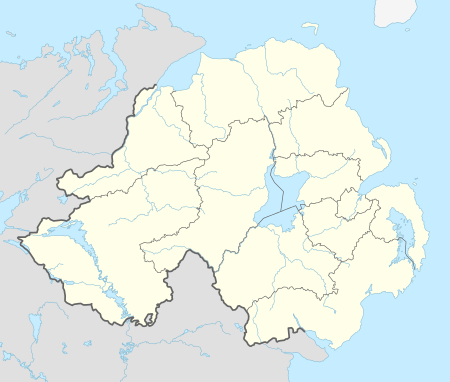Waterloo Bay
| Waterloo Bay | |
|---|---|
|
Tilted mudstones at Waterloo Bay, Larne | |
 Location in Northern Ireland | |
| Location | County Antrim, Northern Ireland |
| OSI/OSNI grid | D408037 |
| Coordinates | 54°51′07″N 5°49′48″W / 54.852°N 5.83°WCoordinates: 54°51′07″N 5°49′48″W / 54.852°N 5.83°W |
| Elevation | 0 m |
| Geology | Mercia Mudstone Group, Lias Group |
| Age | Jurassic, Triassic |
| Topo map | OSNI Discoverer 9 |
Waterloo Bay is an area of foreshore in Larne, Northern Ireland.
The site is of interest to geologists because it provides an unusually clear, complete and accessible example of the sequences from Upper Triassic to Lower Jurassic, when the rock types changed from land to marine.[1]
Protected Status
In 1995, Waterloo Bay was designated an Area of Special Scientific Interest for its geological importance.[1]
In 2007, it was a candidate for Global Boundary Stratotype Section and Point (also known as a GSSP, or 'golden spike') to mark the base of the Jurassic system and Hettangian stage.[2][3][4] although the Kujoch in Austria was chosen instead.
Early investigation
Joseph Ellison Portlock studied the Triassic and Jurassic rocks of Ireland in 1843 as part of his engagement by Ordnance Survey Ireland.[3]
In 1864 Ralph Tate made an investigation of the Triassic rocks of Co Antrim, which he reported to the Geological Society of London.[3]
The 'Larne Sea Dragon'
In 1999, an ichthyosaur, also popularly known as the 'Larne Sea Dragon' or 'Minnis Monster'[5] was found in the Langport Member strata by Brian McGee. Remains were found of the backbone and rib cage, scattered pieces of the front limbs, the lower jaw, and several teeth. These were uncovered by fossil preparator Andy Cowap and put on display in the Ulster Museum.[6]
From 2007-9, while the Ulster Museum was undergoing refurbishment, the ichthyosaur was exhibited in Larne Tourist Information Centre.[7]
Public right of way
The promenade, a footpath between the foreshore and the low cliffs at Waterloo, is a public right of way.[8]
Gallery
 Ammonites are abundant in the mudstone that marks the Jurassic boundary - the primary marker at this site is the ammonite Psiloceras planorbis
Ammonites are abundant in the mudstone that marks the Jurassic boundary - the primary marker at this site is the ammonite Psiloceras planorbis A slump fold in the Triassic Mercia Mudstone Group
A slump fold in the Triassic Mercia Mudstone Group Synaeresis cracks in the mudstone
Synaeresis cracks in the mudstone The most complete example of an ichthyosaur in Northern Ireland was discovered at Waterloo Bay, Larne
The most complete example of an ichthyosaur in Northern Ireland was discovered at Waterloo Bay, Larne
See also
Geology of Northern Ireland
List of rock formations in the United Kingdom
References
- 1 2 Department of the Environment NI, Waterloo ASSI
- ↑ International Commission on Stratigraphy
- 1 2 3 Simms, M J and Jeram, A J (2007) Waterloo Bay, Larne, Northern Ireland: A potential Global Stratotype Section and Point (GSSP) for the base of the Jurassic System, National Museums Northern Ireland
- ↑ Marina Plan Could Be 'Golden-Spiked' (15 May 2007) Larne Times
- ↑ BBC Attic
- ↑ Unearthing the Larne Sea Dragon (2007) National Museums Northern Ireland
- ↑ McIlwaine Biggins, Fiona (15 Nov 2007) 200m year old resident returns home to Larne, Belfast Telegraph
- ↑ Council Papers Confirm Members Labelled Marina Minute Erroneous (1 Dec 2005) Larne Times


